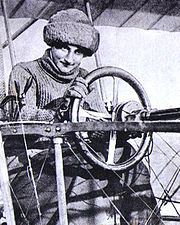The Beauty of Flight: A survey of those who flew early and often
Editor's Note: The death of Sally Ride, the first United States female astronaut, and the occasion of Amelia Earhart's 115 th birthday, led us to this partial history of women who have been pioneers in the aviation field. Though we haven't been able to factcheck the article, it is complete with fascinating details.
In 1784, before America even had its first president, Madame Élisabeth Thible ascended as a balloon passenger in Lyons, France. In 1909 French Baroness Raymonde de Laroche tried flying - a Voisin Biplane. She learned to manipulate the unstable and unpredictable machine and became the first woman licensed to fly by the Fédération Aéronautique Internationale. She was killed in an airplane crash in 1919.
Tiny Broadwick, in 1908 at age 15, became the first person to make a parachute jump from a hot air balloon. She made close to a thousand jumps from balloons while traveling with a carnival and then later demonstrated parachuting from aircraft to the US Army.
In the early days of aviation there were several firsts by women. Bessica Raiche built her own airplane in her living room then flew it on Sept. 16, 1910. Blanche Stuart Scott took up flying with the famous Glenn Curtiss, becoming a member of his exhibition team. He declared her America's first aviatrix on Sept. 6, 1910, though she never obtained a pilot's license.
Harriet Quimby was officially the first with a license obtained from the Moisant School in 1911. Fellow student Mathilde Moisant became number two and later established an altitude record of 1,500 feet. Harriet Quimby traveled to France where she acquired a Bleriot monoplane to attempt a flight across the English Channel. She had no opportunity to flight-test the aircraft and handled a compass for the first time above the fog in the Channel. She returned to America successful and triumphant. Only three months later she died in the unstable Bleriot over Boston harbor.
Katherine Stinson learned to fly in 1912, becoming famous for precision acrobatics and sky-writing. The much-admired Ruth Law was a cohort of Katherine's, becoming an expert exhibition flyer and record holder. She established an American long-distance record flying solo from Chicago to New York.
And an African-American woman, against staggering odds, gained renown in aviation. Bessie Coleman, facing race and gender discrimination, found the door locked at flying schools. So she studied French and sailed for Paris to learn to fly. She returned in 1921, the world's first licensed African-American pilot. "Brave Bessie," as she became known, became a popular attraction on the air show circuit. For some unknown reason, at an air show in 1926, Bessie had failed to wear her parachute and hadn't strapped herself in. A wrench jammed her controls. As the airplane rolled over, Bessie fell to her death.
The early years exacted a horrendous toll on aviation's pioneers. We can hardly comprehend the machines they called airplanes. Nevertheless more eager aviators followed and aviation grew up with women pilots.By 1929 there were over 100 American women (and numerous women in other countries) licensed to fly.
All photographs from Wikipedia.
(1) Raymonde de Laroche in her Voisin aeroplane in 1909
(2) Aviatrix Ruth Law (r) and Mrs. Robert GoeletModel "B" Wright airplane, Daytona Beach, Florida, 1914
More Articles
- National Archives Records Lay Foundation for Killers of the Flower Moon: The Osage Murders and the Birth of the FBI
- Nichola D. Gutgold - The Most Private Roosevelt Makes a Significant Public Contribution: Ethel Carow Roosevelt Derby
- Oppenheimer: July 28 UC Berkeley Panel Discussion Focuses On The Man Behind The Movie
- "Henry Ford Innovation Nation", a Favorite Television Show
- Women at War 1939 - 1945, The Imperial War Museums: Queen Elizabeth
- Julia Sneden Wrote: Going Forth On the Fourth After Strict Blackout Conditions and Requisitioned Gunpowder Had Been the Law
- Jo Freeman Reviews: Gendered Citizenship: The Original Conflict Over the Equal Rights Amendment, 1920 – 1963
- Jo Freeman Writes: It’s About Time
- Jo Freeman Reviews: Lady Bird Johnson: Hiding in Plain Sight
- Women in Congress: Biographical Profiles of Former Female Members of Congress






